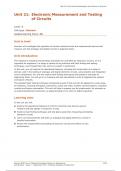UNIT 21: ELECTRONIC MEASUREMENT AND TESTING OF CIRCUITS
Unit 21: Electronic Measurement and Testing
of Circuits
Level: 3
Unit type: Internal
Guided learning hours: 60
Unit in brief
Learners will investigate the operation of common electronic test and measurement devices and
measure and test analogue and digital circuits to diagnose faults.
Unit introduction
The majority of industrial and domestic processes are controlled by electronic circuitry, so it is
important for engineers in a range of sectors to be proficient with fault finding and testing
techniques, even though they may not be an expert in electronics.
In this unit, you will explore the operational features, including the construction of a range of
devices used in the testing of analogue and digital electronic circuits, using discrete and integrated
circuit components. You will also explore fault finding techniques and prepare a test plan for
diagnosing faults. You will go on to measure and test operational circuits to diagnose the location
and nature of faults.
The standard fault finding techniques introduced as part of this unit can be applied to a wide range
of industries, including aerospace, automotive, audio and video, wireless communications, industrial
controls and factory automation. This unit will help to prepare you for employment, for example as
an electrical/electronic technician, an apprenticeship or for entry to higher education.
Learning aims
In this unit you will:
A Explore the operational features of common electronic test devices used to
measure and test signals in electronic circuits
B Examine fault finding techniques and test plans used when measuring and testing
electronic circuits
C Carry out measurements and tests on analogue and digital electronic circuits to
identify faults safely
D Review the measurement and testing of electronic circuits and reflect on own
performance.
Pearson BTEC Level 3 National Foundation Diploma in Engineering – 153
Specification – Issue 7 – September 2019 © Pearson Education Limited 2019
,UNIT 21: ELECTRONIC MEASUREMENT AND TESTING CIRCUITS
Summary of unit
Learning aim Key content areas Recommended
assessment approach
A Explore the operational A1 Operational features of A written report exploring the
features of common measurement devices operational features of typical
electronic test devices used A2 Operational features of measurement and testing
to measure and test signals test devices devices. Learners will explore
the measurement and test
in electronic circuits
devices in the laboratory and
through research.
B Explore fault finding B1 Fault finding techniques A test plan to analyse each
techniques and test plans B2 Preparation for testing and electronic circuit, detailing the
used when measuring and test plans fault finding techniques to be
testing electronic circuits used and preparation tasks to
be undertaken. It will also
explain the rationale behind
the application of different
C1 Safe working practice techniques.
C Carry out measurements
and tests on analogue and C2 Practical fault finding on A logbook and fault finding
analogue and digital record for the circuits, detailing
digital electronic circuits to
circuits tests undertaken, symptoms
identify faults safely
and final identification of the
faulty components in analogue
and digital circuits. One or
more observational witness
statements.
D Review the measurement D1 Lessons learned from Evidence will focus on what
and testing of electronic measuring and testing went well and what did not
circuits and reflect on own electronic circuits go so well when testing and
performance D2 Personal performance measuring electronic circuits,
while measuring and reviewing the processes and
testing electronic circuits reflecting on own performance.
A portfolio of evidence
generated while measuring and
testing electronic circuits and
reviewing the processes and
reflecting on own performance.
154 Pearson BTEC Level 3 National Foundation Diploma in Engineering –
Specification – Issue 7 – September 2019 © Pearson Education Limited 2019
, UNIT 21: ELECTRONIC MEASUREMENT AND TESTING OF CIRCUITS
Content
Learning aim A: Explore the operational features of common electronic test
devices used to measure and test signals in electronic circuits
A1 Operational features of typical measurement devices
x Operational features of multiple range meters (multimeters), to include:
o input impedance and output impedance for different parameters being measured
o reading of analogue and digital displays
o parallax issues with analogue meters
o correct selection of terminals depending on the characteristics being measured
o comparisons between analogue and digital meters
o comparisons between autoranging and manual selection meters.
x Operation of dual beam oscilloscope for accurate measurement of alternating current (AC)
waveform, to include:
o operation of the cathode ray gun
o how the beam is deflected
o how to read a graticule.
x Explanation of oscilloscope features, to include:
o time base
o amplitude
o waveform selector
o trigger selection (internal, external triggering)
o inbuilt calibration facilities.
x Operation of spectrum analyser, to include:
o continuous or swept frequency analysis
o input bandwidth control
o reading of the cathode ray tube (CRT) output.
x Operation of digital test devices, to include:
o logic probe and ‘logic analyser’ for measurement of the output states on digital
electronic circuits
o the points at which logic states change in both complementary metal oxide
semiconductor (CMOS) and transistor-transistor logic (TTL) circuits
o the response the probe gives when in-between the two states.
A2 Operational features of electronic test devices
Operational features of standard test devices, to include:
x stabilised direct current (DC) power supply
x alternating signal generator
x digital pulse generators
x binary word generator.
Learning aim B: Explore fault finding techniques and test plans used when
measuring and testing electronic circuits
B1 Fault finding techniques
Applications and process for different fault finding techniques, to include:
x visual examination:
o generally the first test carried out
o look for signs of burnt or damaged components or broken connections
o check values of components against circuit diagrams to identify any errors
Pearson BTEC Level 3 National Foundation Diploma in Engineering – 155
Specification – Issue 7 – September 2019 © Pearson Education Limited 2019





